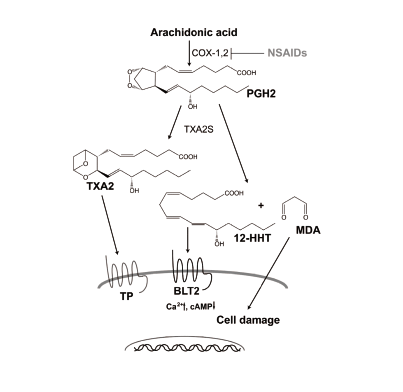12(S)-hydroxyheptadeca-5Z, 8E, 10E-trienoic acid is a natural ligand for leukotriene B4 receptor 2
Activated blood platelets and macrophages metabolize prostaglandin H2 into thromboxane A2 and 12(S)-hydroxyheptadeca-5Z, 8E, 10E-trienoic acid (12-HHT) in an equimolar ratio through the action of thromboxane synthase. Although it has been shown that 12-HHT is abundant in tissues and bodily fluids, this compound has long been viewed as a by-product lacking any specific function. We show that 12-HHT is a natural ligand for leukotriene B4 (LTB4) receptor-2 (BLT2), a G protein-coupled receptor that was originally identified as a low-affinity receptor for LTB4. BLT2 agonistic activity in lipid fractions from rat small intestine was identified as 12-HHT using high-performance liquid chromatography and mass spectrometry. Exogenously expressed BLT2 in mammalian cells was activated by synthetic 12-HHT, as assessed by guanosine 5'-O-(3-thio) triphosphate binding, the activation of intracellular signaling pathways, and chemotaxis assay. Displacement analysis using [3H]LTB4 showed that 12-HHT binds to BLT2 with a higher affinity than LTB4. Lipid extracts from cyclooxygenase 1-deficient mice failed to activate BLT2. Bone marrow-derived mast cells (BMMCs) isolated from wild-type mice migrated toward a low concentration of 12-HHT, whereas BMMCs from BLT2-deficient mice did not. We conclude that 12-HHT is a natural lipid agonist of BLT2 in vivo and induces chemotaxis of mast cells.
Program member
Takao Shimizu (Department of Biochemistry and Molecular Biology, Faculty of Medicine)

Figure 1. Schematic representation of the production and action of 12-HHT.
